Signature of versatility in Chandana’s paintings
By Ranga CHANDRARATHNE
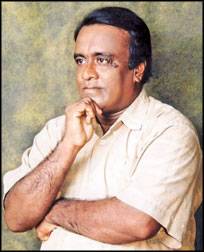 |
|
Chandana Ranaweera |
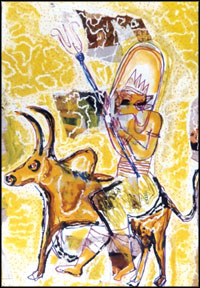
Gona Pita Nagi Deviya |

Hudakala Vu Deviya |
The most striking feature of Chandana Ranaweera’s paintings is his
disarming genuineness in expression. His brush strokes which make
mosaics on the canvas are truly the innermost expression of Sri Lankan
identity with particularly rural flavour. It was the spiritual
nourishment together with unique Sri Lankan culture which makes
Chandana’s painting special and unique even among Sri Lankan painters’
work. His forte seems to be in the line drawings with an omni- present
influence of the moon on almost all of his paintings. He loves painting
under the soothing moonlight using light colours which in a particular
way depicts the indomitable personality of the artist himself. His
preferred media are collage and line drawings.
Examining his early paintings, one may arrive at the conclusion that
Chandana had obviously been influenced particularly by line drawings.
Contrasting to his subsequent paintings, Chandana has used dark
colours for the paintings. Colours such as red, blue and yellow are
prominent. For instance, Chandana has used dark colours for ‘Vesmuna’
(The Mask); blue, red and yellow have been used to make a blurred smug
of a mask. In a symbolic context, Chandana has depicted the
quintessential characteristics of a mask; the wide open mouth, potholes
like eyes and the protruding nose.
However, he has exercised care not to reveal the identity of the
devil so that it becomes a common symbol of devil’s mask. The “Nelum
Vila “(Lotus Pond) which was also one of his early paintings, shows the
same maturity as the Vesmuna. Primarily the painter has used blue and
red for the painting. Blue has been used to indicate the water while red
has been used to depict the lotus. Obviously the influence of line
drawing is manifested in both paintings.
|
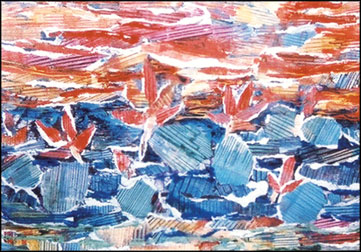
Lotus pond |
“Nai Natawanna:” (Snake Charmer) which also belongs to early
paintings, however, is different from previous creations. Here the
drawing assumes an abstract nature. The snake as well as the snake
charmer is blurred. As if through a fog, that one can see the snake,
snake charmer and the men by his side. Red, pink and black have been
used for the paintings. Once again the artist has made it a point not to
make the painting a common portrait of a snake charmer.
It is a common sight in village fairs that snake charmers display the
snakes in public. On Some instances, snake charmers happen to be
indigenous drug sellers and on others they happen to be snake charmers
in the gypsy community. The sheer abstract nature of the
drawing-has-made it a universal, experience.
The subsequent paintings such as ‘Buddha Sarasili’ (Buddhist
Decorations -2000), ‘Gona Pita Nagi Deviya’ (The God on the Bull-2003)
and ‘Hudakala Vu Deviya’ (The God in isolation -2003) are different and
perhaps, mark a departure from the earlier practice. For instance in
Buddha Sarasili’, the artist has used yellow as the primary colour of
the background of the figures. Symbolism such as writing on the stone
tablets and Sandakada Pahana (crescent-like decoration) which is a
prominent feature of Buddhist sculptures in the Anuradhapura era has
been used.
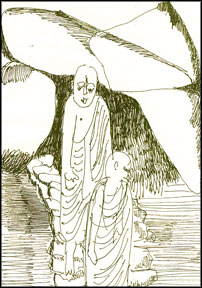  |
The painting, “Gona Pita Nagi Deviya”, in a way, is satirical. Here
the painter has used dark colours as yellow. The god who got on top of
the bull holds a trident in his hand. The trident is a mythical weapons
of power in Hindu mythology. The figure of god in ‘Hudakala Vue Deviya’
is, apparently dedicated to god. However, the surrounding is covered
with weeds which indicate that the god has been abandoned or the temple
has been neglected by the devotees. For this painting, the artist has
used yellow, green and red.
Compared to the earlier creations, one can observe a change of style
and obviously the artist has been influenced by contemporary trends in
paintings. However, even at this latter stage of paintings, one of the
prominent features of the painting is the use of dark colours. For
instance, red and yellow have been prominently used in the paintings.
Figures of the god have been used in some paintings, sometimes, taken
out of traditional temple atmosphere. For instance, in the painting
“Gona Pita Nagi Deviya”, the much venerated god is on top of a bull.
Although holding a trident, the figure of god is not in a venerated
position. In fact, God is in a hilarious position. Dark colours have
been used for the painting.
|
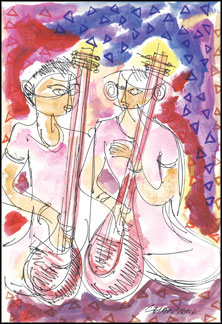
Sitar Players |
Chandana’s contemporary paintings like line drawings reflect a
different trend. It is a complete departure from the previous creations.
For them light colours have been used. The painting “Trees” which is a
line drawing, yellow has been used. Under the soothing light of the
moon, the artist has captured the trees bathed in moon light. Paintings
“Flower Pickers”, “The Coconut Oil Lamp “and “Sitar Players”, colours
have been used sparingly. For instance, in the painting “Flower
pickers”, blue, green and red have been used judiciously. The two women
flower pickers are depicted in green and red.
Techniques of line drawings have been generously used. “Sitar
players” is also an example where the artist has extensively employed
techniques in line drawings. Pink has been used to paint the two sitar
players while blue, pink and red interspersed with triangular have been
used as a background. The artist’s other line drawings such as ‘Bats’, “
Rain and Sea Waves”, “ Vesak Decorations” , “ Lena Thulin Pitathata “
(emerging out of the cave) are on different themes. These line drawings
are marked for their sparingly use of objects. For instance, in the
“Bats”, the artist has only used dark figures of three bats against the
backdrop of a starry night. Over the years, artist Chandana Ranaweera
has devised his own style of painting and diction which has been
matured. He has chosen line drawings and collage as media for his
creations.
Following the footsteps of his father who was an instructor in arts,
Chandana Ranaweera entered the field of art. During his student days at
Maliyadeva Boys’ School in Kurunegala, Ranaweera’s creativity flourished
under the guidance of art teacher S. M. Jayatilake. He followed a course
of study conducted by veteran artist Sumana Dissanayake. On completion
of his education, he joined Lanka Kala Sangamaya where he followed a
one-year course in art in 1989. He held his maiden exhibition of
paintings entitled “Ehipasiko “at the public library. It was a mix-media
including collage, graphics and line drawings on themes such as
drummers, the Buddha and life in general. In 1992 he held an exhibition
of line drawings entitled “Nawatha Emathima” at the Public Library,
Colombo in 1994, Chandana held an exhibition of line drawings entitled
“Varnarekha Kavya”. In 2000 he held an exhibition of paintings entitled
“Samadhi Chinthana” at the Lionel Wendt Art Gallery. The surprise visit
by the then Indian High Commissioner in Sri Lanka Gopala Krishna Gandhi
and Tara Krishna Gandhi, on reading an article on Chandana’s paintings
by Prof. Ashley Halpe, had been an encouragement for Chandana. The
exhibitions by Chandana include “Samadhi Chintha” I, II, II and Line
Lyrics at Alliance Francaise in Kandy.
He has represented Sri Lanka at international exhibitions held in
India, Japan and Bangladesh. The UN has used his paintings on numerous
occasions for picture post cards in 1991. For the picture post cards,
only four artists’ works have been selected. In addition his paintings
have been used as cover pictures for Shahitya Kalapola, a publication by
the Department of Cultural Affairs.
|

